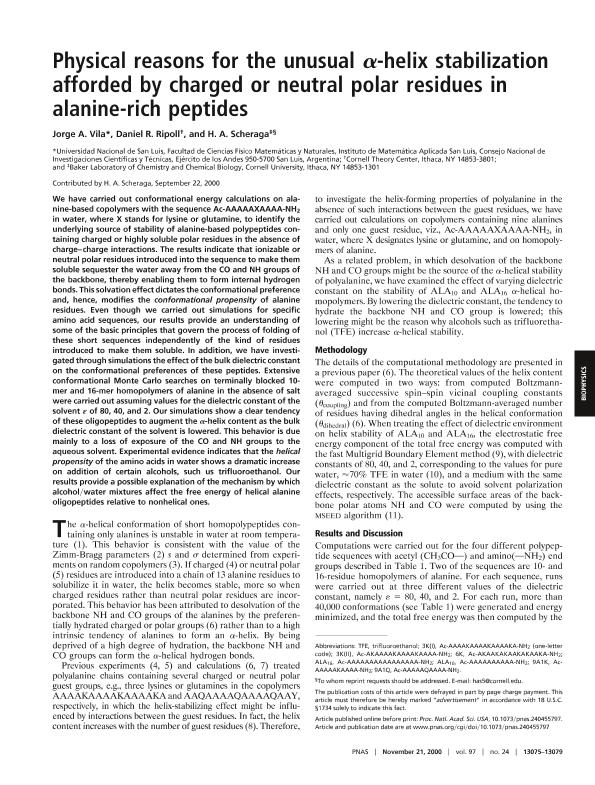Mostrar el registro sencillo del ítem
dc.contributor.author
Vila, Jorge Alberto

dc.contributor.author
Ripoll, Daniel R.
dc.contributor.author
Scheraga, Harold A.

dc.date.available
2020-11-12T14:24:18Z
dc.date.issued
2000-11
dc.identifier.citation
Vila, Jorge Alberto; Ripoll, Daniel R.; Scheraga, Harold A.; Physical reasons for the unusual α-helix stabilization afforded by charged or neutral polar residues in alanine-rich peptides; National Academy of Sciences; Proceedings of the National Academy of Sciences of The United States of America; 97; 24; 11-2000; 13075-13079
dc.identifier.issn
0027-8424
dc.identifier.uri
http://hdl.handle.net/11336/118254
dc.description.abstract
We have carried out conformational energy calculations on alanine-based copolymers with the sequence Ac-AAAAAXAAAA-NH2 in water, where X stands for lysine or glutamine, to identify the underlying source of stability of alanine-based polypeptides containing charged or highly soluble polar residues in the absence of charge-charge interactions. The results indicate that ionizable or neutral polar residues introduced into the sequence to make them soluble sequester the water away from the CO and NH groups of the backbone, thereby enabling them to form internal hydrogen bonds. This solvation effect dictates the conformational preference and, hence, modifies the conformational propensity of alanine residues. Even though we carried out simulations for specific amino acid sequences, our results provide an understanding of some of the basic principles that govern the process of folding of these short sequences independently of the kind of residues introduced to make them soluble. In addition, we have investigated through simulations the effect of the bulk dielectric constant on the conformational preferences of these peptides. Extensive conformational Monte Carlo searches on terminally blocked 10-mer and 16-mer homopolymers of alanine in the absence of salt were carried out assuming values for the dielectric constant of the solvent ε of 80, 40, and 2. Our simulations show a clear tendency of these oligopeptides to augment the α-helix content as the bulk dielectric constant of the solvent is lowered. This behavior is due mainly to a loss of exposure of the CO and NH groups to the aqueous solvent. Experimental evidence indicates that the helical propensity of the amino acids in water shows a dramatic increase on addition of certain alcohols, such us trifluoroethanol. Our results provide a possible explanation of the mechanism by which alcohol/water mixtures affect the free energy of helical alanine oligopeptides relative to nonhelical ones.
dc.format
application/pdf
dc.language.iso
eng
dc.publisher
National Academy of Sciences

dc.rights
info:eu-repo/semantics/openAccess
dc.rights.uri
https://creativecommons.org/licenses/by-nc-sa/2.5/ar/
dc.subject
HELIX
dc.subject
STABILIZATION
dc.subject.classification
Física Atómica, Molecular y Química

dc.subject.classification
Ciencias Físicas

dc.subject.classification
CIENCIAS NATURALES Y EXACTAS

dc.title
Physical reasons for the unusual α-helix stabilization afforded by charged or neutral polar residues in alanine-rich peptides
dc.type
info:eu-repo/semantics/article
dc.type
info:ar-repo/semantics/artículo
dc.type
info:eu-repo/semantics/publishedVersion
dc.date.updated
2020-09-03T19:25:34Z
dc.journal.volume
97
dc.journal.number
24
dc.journal.pagination
13075-13079
dc.journal.pais
Estados Unidos

dc.journal.ciudad
Washington DC, USA
dc.description.fil
Fil: Vila, Jorge Alberto. Consejo Nacional de Investigaciones Científicas y Técnicas. Centro Científico Tecnológico Conicet - San Luis. Instituto de Matemática Aplicada de San Luis "Prof. Ezio Marchi". Universidad Nacional de San Luis. Facultad de Ciencias Físico, Matemáticas y Naturales. Instituto de Matemática Aplicada de San Luis "Prof. Ezio Marchi"; Argentina
dc.description.fil
Fil: Ripoll, Daniel R.. Cornell Theory Center; Estados Unidos
dc.description.fil
Fil: Scheraga, Harold A.. Cornell University; Estados Unidos
dc.journal.title
Proceedings of the National Academy of Sciences of The United States of America

dc.relation.alternativeid
info:eu-repo/semantics/altIdentifier/url/https://www.pnas.org/content/97/24/13075
dc.relation.alternativeid
info:eu-repo/semantics/altIdentifier/doi/https://doi.org/10.1073/pnas.240455797
Archivos asociados
